Coesfeld
Coesfeld (German pronunciation: [ˈkoːsfɛlt]) is the capital of the district of Coesfeld in the German state of North Rhine-Westphalia.
Coesfeld | |
|---|---|
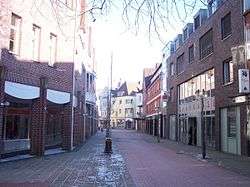 | |
 Coat of arms | |
Location of Coesfeld within Coesfeld district 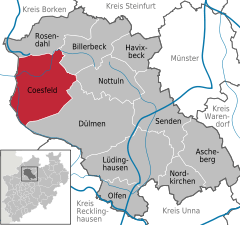  | |
 Coesfeld 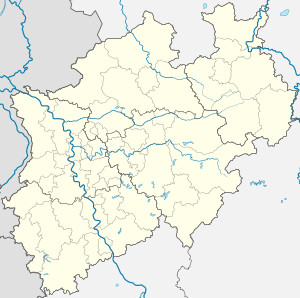 Coesfeld | |
| Coordinates: 51°57′N 7°10′E | |
| Country | Germany |
| State | North Rhine-Westphalia |
| Admin. region | Münster |
| District | Coesfeld |
| Subdivisions | 2 |
| Government | |
| • Mayor | Heinz Öhmann (CDU) |
| Area | |
| • Total | 141.05 km2 (54.46 sq mi) |
| Elevation | 89 m (292 ft) |
| Population (2018-12-31)[1] | |
| • Total | 36,217 |
| • Density | 260/km2 (670/sq mi) |
| Time zone | CET/CEST (UTC+1/+2) |
| Postal codes | 48653 |
| Dialling codes | 02541 |
| Vehicle registration | COE |
| Website | www.coesfeld.de |
History
Coesfeld received its city rights in 1197, but was first recorded earlier than that in the biography of St. Ludger, patron and first bishop of the diocese of Munster who was born north of Coesfeld in Billerbeck. The day before he died, Ludger spent the night in Coesfeld and heard mass in the morning in the church he founded. He was on his way from his abbey in Essen to Münster. The road he followed passed Coesfeld and Billerbeck, and after preaching in the St. Lambert's church, 26 March 809, he travelled on to Billerbeck, where he died in the evening.
The Coesfeld St. Jacobikirche dates from the same period as the city charter. For centuries, Coesfeld was an important stopping place for pilgrims traveling one of the more popular Germanic Jakobi routes (Way of St. James) leading from Warendorf over Münster (via Billerbeck) to Coesfeld, and then on via Borken to Wesel on the Rhine.
Bernhard von Galen
During the Thirty Years War, troops were stationed in Coesfeld. The Prince-bishop of Münster was often at odds with these troops. Bernhard von Galen managed to drive the foreign troops away and even started to build a palace in Coesfeld, but it was never finished and after he died it was torn down. He became known for his sieges of Dutch cities in his efforts for the counter reformation and started a Way of the Cross procession that still exists up to the present day, with 18 stations of the cross. One procession round the historic centre of Coesfeld is still held on Whitmonday but the "Great Procession along the stations of the cross" held for centuries on Whit Tuesday is now held on 9/14 (Exaltation of the Cross) if it is a Sunday otherwise on the Sunday thereafter.
[See German language version for somewhat more detailed history.]
Geography
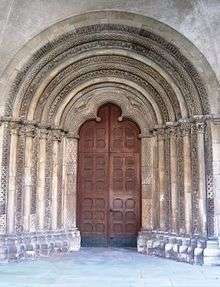
Coesfeld is situated in the Baumberge in Münsterland.
Neighbouring municipalities
Divisions
Coesfeld consists of 2 subdivisions:
- Coesfeld
- Lette
Education
Major secondary schools are:
- the Nepomucenum,
- the Heriburg-Gymnasium
- and the St.-Pius-Gymnasium.
Persons of interest
- Leunclavius (1541–1594), humanist, legal scholar, Greek scholar and historian
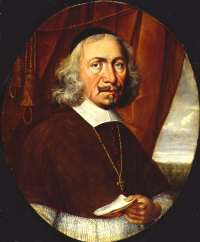
- Christoph Bernhard von Galen (1606-1678), Bishop of Münster, Coesfeld built from a bishopric.
- Anne Catherine Emmerich, (1774-1824), Roman Catholic nun, visionary and stigmatic
- Otto Bräutigam (1895-1992 in Coesfeld), lawyer and diplomat, took part in the Holocaust
- Rudolf Wolters (1903-1983), architect and urban planner, close associate of Albert Speer
- Hermann Wedekind (1910-1998), artistic director
- Michael Oenning (born 1965), football player and coach
References
- "Bevölkerung der Gemeinden Nordrhein-Westfalens am 31. Dezember 2018" (in German). Landesbetrieb Information und Technik NRW. Retrieved 10 July 2019.
External links
![]()
- . Encyclopædia Britannica (11th ed.). 1911.
- Official website
